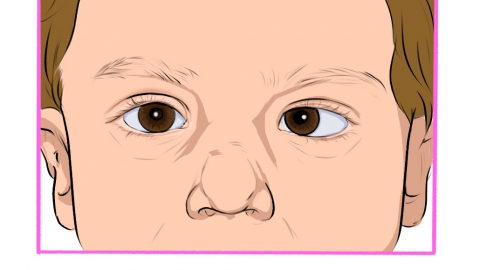How is strabismus treated in children?
Generally, pediatric strabismus may be caused by congenital abnormalities of the extraocular muscles, uncorrected refractive errors, intermittent exotropia, comitant esotropia, or paralytic strabismus. It is recommended to seek timely medical attention, identify the underlying cause, and then improve the condition under a doctor's guidance through general treatments, medications, surgical interventions, and other approaches. A detailed analysis is as follows:

1. Congenital Abnormalities of Extraocular Muscle Development: Uneven development of the extraocular muscles during fetal stages can lead to uncoordinated eye movements and strabismus after birth. Early ophthalmic examination is necessary, with the optimal treatment period between ages 3-6. In daily life, covering the healthy eye and practicing eye movements can help train the affected eye and promote the development of binocular vision.
2. Uncorrected Refractive Errors: Refractive issues such as myopia, hyperopia, or astigmatism in children that are not corrected promptly with appropriate glasses may cause the eyes to over-accommodate in an attempt to see clearly, which can lead to strabismus. It is important to visit a reputable hospital for refraction testing and glasses fitting, have regular vision check-ups, adjust the glasses prescription according to vision changes, and avoid excessive accommodation that could worsen strabismus.
3. Intermittent Exotropia: Exotropia may occur in children when their attention is unfocused or when they are fatigued, but the eyes may return to normal alignment when attention is focused. Long-term, this condition may progress to constant strabismus. In daily life, reduce screen time to avoid eye fatigue. Follow medical advice to use medications such as atropine sulfate ophthalmic gel, compound tropicamide eye drops, or tropicamide eye drops to relax the ciliary muscles, and combine with strabismus training to improve symptoms.
4. Comitant Esotropia: The visual axes of both eyes are not parallel, causing one eye to deviate inward when looking at the same object, often associated with uncorrected hyperopia. Initially, corrective hyperopic glasses should be worn. If strabismus does not improve after wearing glasses, follow medical advice to use medications such as botulinum toxin type A for injection, atropine sulfate ophthalmic gel, or tropicamide eye drops as adjunctive therapy. If necessary, bilateral medial rectus recession surgery may be performed to adjust the strength of the extraocular muscles and restore proper eye alignment.
5. Paralytic Strabismus: Paralysis of the extraocular muscles leads to restricted eye movement and strabismus, often accompanied by diplopia and dizziness. The underlying cause should be identified first. If caused by neuritis, follow medical advice to use medications such as mecobalamin tablets, vitamin B1 tablets, or vitamin B12 injections to nourish the nerves. Once the condition stabilizes, surgical correction for extraocular muscle palsy may be performed to repair the paralyzed muscles or adjust the antagonist muscles' strength, improving ocular motility function.
In daily life, it is important to cultivate proper eye habits in children, maintain good posture, and avoid prolonged close-up viewing. Encourage children to participate in outdoor activities, ensuring 1-2 hours of outdoor time daily. Through scientific care and standardized treatment, children can achieve normal eye alignment and maintain healthy binocular vision function.





